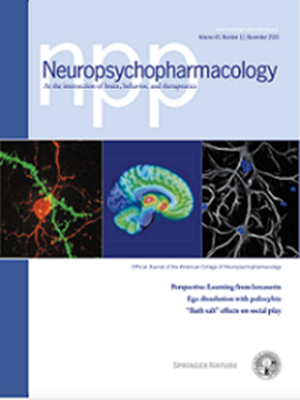抗精神病药medication-naïve首发精神病患者的皮质髓鞘定位。
IF 6.6
1区 医学
Q1 NEUROSCIENCES
引用次数: 0
摘要
虽然白质髓磷脂的主要功能是加速传导速度,并在精神分裂症谱系障碍(SSD)中得到了广泛的研究,但对灰质髓磷脂在SSD中的作用知之甚少。皮层髓鞘形成主要发生在小白蛋白阳性(PV+)中间神经元的近端轴突,在那里它有助于营养支持和经验依赖的可塑性。鉴于PV+中间神经元功能障碍在SSD中的作用,在这种情况下,提高我们对皮质髓鞘病理的理解是至关重要的。在这里,我们使用大量抗精神病药物medication-naïve首发精神病患者的T1w/T2w比值量化髓磷脂图谱。我们使用MANCOVA比较了患者(N = 91)和对照组(N = 107)之间的髓磷脂含量,并计算了每个区域与判别函数的零阶相关性,然后使用机器学习方法使用逐步算法识别驱动组差异的最简约的皮质区域群。组成员与T1w/T2w比值显著相关(Wilks Lambda = 0.09, p本文章由计算机程序翻译,如有差异,请以英文原文为准。

Cortical myelin mapping in antipsychotic medication-naïve, first-episode psychosis patients
While white matter myelin primarily functions to accelerate conduction velocity and has been extensively studied in schizophrenia-spectrum disorders (SSD), less is known about the role of gray matter myelin in SSD. Cortical myelination occurs mostly on the proximal axons of parvalbumin positive (PV+) interneurons, where it assists in trophic support and experience-dependent plasticity. Given the role of PV+ interneuron dysfunction in SSD, it is critical to advance our understanding of cortical myelin pathology in this context. Here, we quantified myelin maps using the T1w/T2w ratio in a large group of antipsychotic medication-naïve, first-episode psychosis patients. We compared myelin content between patients (N = 91) and controls (N = 107) using a MANCOVA and calculated zero-order correlations with the discriminant function for each region, then used a machine learning approach to identify the most parsimonious constellation of cortical regions driving group differences using a stepwise algorithm. Group membership was significantly associated with T1w/T2w ratio (Wilks Lambda = 0.09, p < 0.01), where patients had higher myelin values compared to healthy controls. We identified a subset of 16 regions, primarily located in association cortices, that were sufficient to explain group differences. Here, we report an increase in the cortical T1w/T2w ratio in association cortices in first-episode psychosis. We suggest that faulty myelin compaction during this critical developmental period could contribute to PV+ interneuron pathology and cortical microcircuit disruptions resulting in the clinical phenotype. With additional empirical support from future studies, novel treatment strategies targeting cortical myelin could have potential to mitigate circuit dysfunction in the illness.
求助全文
通过发布文献求助,成功后即可免费获取论文全文。
去求助
来源期刊

Neuropsychopharmacology
医学-精神病学
CiteScore
15.00
自引率
2.60%
发文量
240
审稿时长
2 months
期刊介绍:
Neuropsychopharmacology is a reputable international scientific journal that serves as the official publication of the American College of Neuropsychopharmacology (ACNP). The journal's primary focus is on research that enhances our knowledge of the brain and behavior, with a particular emphasis on the molecular, cellular, physiological, and psychological aspects of substances that affect the central nervous system (CNS). It also aims to identify new molecular targets for the development of future drugs.
The journal prioritizes original research reports, but it also welcomes mini-reviews and perspectives, which are often solicited by the editorial office. These types of articles provide valuable insights and syntheses of current research trends and future directions in the field of neuroscience and pharmacology.
 求助内容:
求助内容: 应助结果提醒方式:
应助结果提醒方式:


